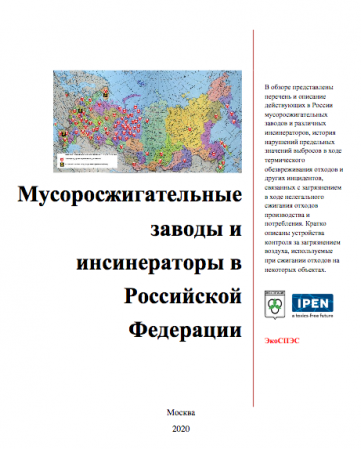Waste incineration facilities and incinerators in the Russian Federation
How many incinerators, waste burning facilities, and cremators are there in your city or region? What is known about these technologies and what danger do they pose?
Waste incineration facilities are considered to be one of the main sources of dioxin emissions. No matter how minuscule the emission of these toxic substances are, they remain in the environment for years, accumulating in ecosystems and in the fatty tissues of living organisms. Therefore, even around the newest and most modern incinerators a poisoned zone is formed. Numerous studies confirm that the impact of emissions from waste incineration facilities leads to an increase in the concentration of dioxins in the blood of factory workers, the growth of cancer cases, especially lung and respiratory system cancer, an increase in the number of congenital abnormalities, heart disease of newborns, and premature birth.
However, this is by no means a complete list of problems caused by environmental pollution from waste incineration. Recent studies by the International Pollutants Elimination Network (IPEN) conducted in various countries have shown food chain dioxin contamination caused by waste burning.[1]
The review "Waste incineration facilities and incinerators in the Russian Federation" prepared by ECOSpes, "Eco-Accord" and IPEN, contains information on 1156 incinerators operating in Russia. Using specific examples from the experience of environmental activists, it is possible to learn about the effectiveness of industrial environmental control in the Russian regions over waste incineration facilities, and how accessible the results of environmental monitoring are for the general public.
Today, Russia is offered 270 different types of incinerators and cremators manufactured domestically or imported, including mobile units. Minimum or no information is available about health and environmental hazards they may cause.
Non-governmental organizations advocate for disclosure of information on emissions from waste incineration, including emissions of persistent chemical compounds. The review provides recommendations on how the public can seek information on the thermal waste disposal facilities located in the cities, towns and communities. Step-by-step instructions on how to prepare appeals to government agencies responsible for control of chemical emissions in Russia are provided.
The review "Waste incineration plants and incinerators in the Russian Federation" is available at on the "Eco-Accord" website:
http://www.ecoaccord.org/news2020/%D0%9E%D0%B1%D0%B7%D0%BE%D1%80%2015.06.2020.pdf
A related press release (in Russian) can be found here
This project relates to Sustainable Development Goals 11, 12, 14 and 15.
For more information, please contact:
Dmitry Levashov, Eco-SPES, eco-dzerzhinsk@yandex.ru.
Olga Speranskaya, senior advisor, IPEN/"Eco-Accord", speransk2004@mail.ru
Special thanks to IPEN's Eastern Europe, Caucasus, and Central Asia (EECCA) Regional Coordinator Dr. Olga Speranskaya and EECCA Regional Hub Eco-Accord for their important contributions to the development and finalization of the project.

